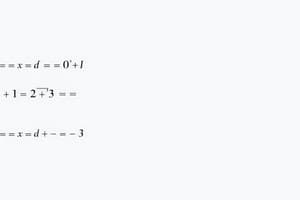Podcast
Questions and Answers
What is the necessary condition for two lines to be parallel?
What is the necessary condition for two lines to be parallel?
- They have the same slope-intercept form.
- They have the same gradient. (correct)
- They have the same x-intercept.
- They have the same y-intercept.
What form of the equation of a line should be used to easily identify the gradient?
What form of the equation of a line should be used to easily identify the gradient?
- Standard form. (correct)
- Point-slope form.
- Intercept form.
- Slope-intercept form.
What is the primary purpose of using the point-slope form when finding the equation of a parallel line?
What is the primary purpose of using the point-slope form when finding the equation of a parallel line?
- To simplify the equation of the line.
- To use the given point and gradient to find the equation of the line. (correct)
- To find the slope of the line.
- To find the y-intercept of the line.
What should be done to the equation of a parallel line after using the point-slope form?
What should be done to the equation of a parallel line after using the point-slope form?
What is a key difference between parallel lines and identical lines?
What is a key difference between parallel lines and identical lines?
Why is it necessary to ensure the given line's equation is in the gradient-intercept form?
Why is it necessary to ensure the given line's equation is in the gradient-intercept form?
If two lines are parallel, what can be said about their gradients?
If two lines are parallel, what can be said about their gradients?
What is the first step in finding the equation of a parallel line?
What is the first step in finding the equation of a parallel line?
What is the primary purpose of using the gradient-intercept form of the equation of a line?
What is the primary purpose of using the gradient-intercept form of the equation of a line?
If a line has a gradient of 2, what is the gradient of a line parallel to it?
If a line has a gradient of 2, what is the gradient of a line parallel to it?
What is true about the y-intercepts of parallel lines?
What is true about the y-intercepts of parallel lines?
What is the equation of a line parallel to the line y = 2x + 3, passing through the point (1, 5)?
What is the equation of a line parallel to the line y = 2x + 3, passing through the point (1, 5)?
What is the relationship between the gradients of two parallel lines and their respective y-intercepts?
What is the relationship between the gradients of two parallel lines and their respective y-intercepts?
A line passes through the point (2, 3) and is parallel to the line y = 3x - 2. What is the equation of the line in slope-intercept form?
A line passes through the point (2, 3) and is parallel to the line y = 3x - 2. What is the equation of the line in slope-intercept form?
What is the primary reason for ensuring the given line's equation is in the standard form y = mx + c?
What is the primary reason for ensuring the given line's equation is in the standard form y = mx + c?
If two lines are parallel, which of the following statements is TRUE?
If two lines are parallel, which of the following statements is TRUE?
What is the purpose of using the point-slope form when finding the equation of a parallel line?
What is the purpose of using the point-slope form when finding the equation of a parallel line?
If a line has a gradient of -2, what is the gradient of a line parallel to it?
If a line has a gradient of -2, what is the gradient of a line parallel to it?




